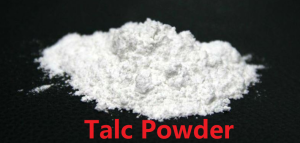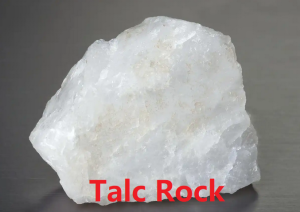What is Talc?
What is Talc?
Talc is a common silicate mineral with a very soft and smooth texture. It is formed by hydrothermal alteration, usually in the form of blocks, leaves, fibers or radiation, with a color mainly white or gray white, but may also appear in various colors due to the presence of other impurities.

What is the application for Talc?
Talc powder is a non-metallic mineral powder mainly composed of magnesium silicate, which has the advantages of fire resistance, heat insulation, high temperature resistance, good water absorption performance, and high stability. Talc powder is widely used in the manufacturing of ceramics, rubber, plastics, paints, coatings, paper, cosmetics and other fields
- Industrial application: The flexibility and high temperature resistance of talc make it an ideal choice for manufacturing various friction materials, such as friction plates, bearings, gaskets, etc. In addition, talc can also be used to manufacture industrial raw materials such as plastics, rubber, and paint.
- Architectural applications: The flexibility and corrosion resistance of talc make it an ideal choice for building materials, such as for manufacturing wall panels, ceilings, floors, etc.
- Medical use: Talc has good adsorption properties and can be used to manufacture adsorbents, pharmaceutical packaging, and other medical supplies.
- Beauty application: The softness and smoothness of talc make it an ideal choice for beauty tools, such as making massage boards, massage balls, etc.
- Decorative use: The color and texture of talc make it an ideal choice for decorative materials, such as making sculptures, decorations, etc.
How to choose the appropriate talc powder ? Which is used in Ceramics,Rubber,plastics,paints,coatings,paper,cosmetics industry?
- Clarify the purpose: Determine the grade and specifications of the required talc powder according to specific needs, such as chemical grade, ceramic grade, cosmetic grade, pharmaceutical and food grade, papermaking grade, etc. Different levels of talc powder have differences in performance and usage.
- Appearance observation: High quality talcum powder should be white or off white, fine, and sand free powder, with a smooth feeling when touched by hand. The block shaped talc aggregate should be irregular in shape, with a waxy luster, soft and delicate in texture, smooth to the touch, non hygroscopic, and not disintegrate when placed in water.
- Color and purity: Pure talc usually appears white, and a darker color may indicate the presence of more impurities.
- Understand performance characteristics: For example, talc powder with lubrication, fire resistance, acid resistance, insulation, and good covering power is usually of good quality.
- Price: You can learn about the prices of different brands and specifications of talc powder through multiple channels to avoid purchasing products with low or high prices, but you cannot judge product quality solely based on price.

Recommended particle size of talc powder
The particle size of talc powder usually refers to the size of the particles in the powder, which is generally divided into four types: ultrafine powder, fine powder, medium powder, and coarse powder. Different particle sizes of talc powder are also suitable for different fields. The following are recommendations and differences of talc powders with different particle sizes.
- Ultra fine powder
Particle size less than 3 microns, usually used in polymer materials, cosmetics, food, medicine and other fields, with properties such as thickening, improving fluidity, lubrication, etc., which can enhance the fluidity and delicacy of products.
- Fine powder
The particle size is between 3-10 microns and is commonly used in the fields of ceramics and coatings. It has properties such as increased hardness, durability, reduced settling, increased viscosity, and wear resistance.
- Medium powder
The particle size is between 10-45 microns and is commonly used in fields such as rubber, plastic, pulp, ink, etc. It has properties such as enhancing hardness, increasing flexibility, improving coating performance, and reducing costs.
- Coarse powder
The particle size is between 45-150 microns and is commonly used in the field of building materials, such as gypsum, artificial stone, cement, etc. It has properties such as increasing stability, improving durability, and reducing costs.

